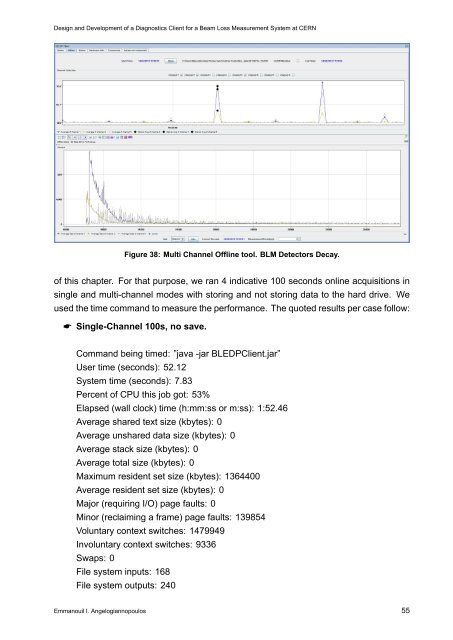Design and Development of a Diagnostics Client for a Beam Loss ...
Design and Development of a Diagnostics Client for a Beam Loss ... Design and Development of a Diagnostics Client for a Beam Loss ...
Design and Development of a Diagnostics Client for a Beam Loss Measurement System at CERN Figure 37: Multi Channel Acquisition. Status Tab. enough to successfully perform all the demanded functions. Another important factor that affects the reliability and effectiveness of the client application is its efficiency. This includes the system crash rate and unexpected behavior. Many problems of this nature arose during the development process, but the end product, after all the required testing and bug fixing, proved to be stable enough for operational usage. A last important factor that reflects the success of the end product is the user satisfaction rate. This criteria is closely dependent on the system performance and behavior. The main users of this application are the developers of the BLEDP FPGAs, members of the BLM team and also sometimes the operators’ crew in the Cern Control Center (CCC). During the development period, the application received many positive responses from its users, whereby it could be concluded that it satisfies the main function it is employed to fulfill. 5.1.2 Performance It could be very interesting to measure the performance of the application in a typical computer system, such as the one mentioned for the remote connection in the beginning Emmanouil I. Angelogiannopoulos 54
Design and Development of a Diagnostics Client for a Beam Loss Measurement System at CERN Figure 38: Multi Channel Offline tool. BLM Detectors Decay. of this chapter. For that purpose, we ran 4 indicative 100 seconds online acquisitions in single and multi-channel modes with storing and not storing data to the hard drive. We used the time command to measure the performance. The quoted results per case follow: ☛ Single-Channel 100s, no save. Command being timed: ”java -jar BLEDPClient.jar” User time (seconds): 52.12 System time (seconds): 7.83 Percent of CPU this job got: 53% Elapsed (wall clock) time (h:mm:ss or m:ss): 1:52.46 Average shared text size (kbytes): 0 Average unshared data size (kbytes): 0 Average stack size (kbytes): 0 Average total size (kbytes): 0 Maximum resident set size (kbytes): 1364400 Average resident set size (kbytes): 0 Major (requiring I/O) page faults: 0 Minor (reclaiming a frame) page faults: 139854 Voluntary context switches: 1479949 Involuntary context switches: 9336 Swaps: 0 File system inputs: 168 File system outputs: 240 Emmanouil I. Angelogiannopoulos 55
- Page 5 and 6: ΠΕΡΙΛΗΨΗ Ο Ευρωπαι
- Page 7 and 8: ACKNOWLEDGMENTS I would like to exp
- Page 9 and 10: 4.4.5 Status Data Displays . . . .
- Page 11 and 12: Figure 23: Offline tab without data
- Page 13 and 14: INTRODUCTION The Large Hadron Colli
- Page 15 and 16: Design and Development of a Diagnos
- Page 17 and 18: Design and Development of a Diagnos
- Page 19 and 20: Design and Development of a Diagnos
- Page 21 and 22: Design and Development of a Diagnos
- Page 23 and 24: Design and Development of a Diagnos
- Page 25 and 26: Design and Development of a Diagnos
- Page 27 and 28: Design and Development of a Diagnos
- Page 29 and 30: Design and Development of a Diagnos
- Page 31 and 32: Design and Development of a Diagnos
- Page 33 and 34: Design and Development of a Diagnos
- Page 35 and 36: Design and Development of a Diagnos
- Page 37 and 38: Design and Development of a Diagnos
- Page 39 and 40: Design and Development of a Diagnos
- Page 41 and 42: Design and Development of a Diagnos
- Page 43 and 44: Design and Development of a Diagnos
- Page 45 and 46: Design and Development of a Diagnos
- Page 47 and 48: Design and Development of a Diagnos
- Page 49 and 50: Design and Development of a Diagnos
- Page 51 and 52: Design and Development of a Diagnos
- Page 53 and 54: Design and Development of a Diagnos
- Page 55: Design and Development of a Diagnos
- Page 59 and 60: Design and Development of a Diagnos
- Page 61 and 62: Design and Development of a Diagnos
- Page 63 and 64: Design and Development of a Diagnos
<strong>Design</strong> <strong>and</strong> <strong>Development</strong> <strong>of</strong> a <strong>Diagnostics</strong> <strong>Client</strong> <strong>for</strong> a <strong>Beam</strong> <strong>Loss</strong> Measurement System at CERN<br />
Figure 38: Multi Channel Offline tool. BLM Detectors Decay.<br />
<strong>of</strong> this chapter. For that purpose, we ran 4 indicative 100 seconds online acquisitions in<br />
single <strong>and</strong> multi-channel modes with storing <strong>and</strong> not storing data to the hard drive. We<br />
used the time comm<strong>and</strong> to measure the per<strong>for</strong>mance. The quoted results per case follow:<br />
☛ Single-Channel 100s, no save.<br />
Comm<strong>and</strong> being timed: ”java -jar BLEDP<strong>Client</strong>.jar”<br />
User time (seconds): 52.12<br />
System time (seconds): 7.83<br />
Percent <strong>of</strong> CPU this job got: 53%<br />
Elapsed (wall clock) time (h:mm:ss or m:ss): 1:52.46<br />
Average shared text size (kbytes): 0<br />
Average unshared data size (kbytes): 0<br />
Average stack size (kbytes): 0<br />
Average total size (kbytes): 0<br />
Maximum resident set size (kbytes): 1364400<br />
Average resident set size (kbytes): 0<br />
Major (requiring I/O) page faults: 0<br />
Minor (reclaiming a frame) page faults: 139854<br />
Voluntary context switches: 1479949<br />
Involuntary context switches: 9336<br />
Swaps: 0<br />
File system inputs: 168<br />
File system outputs: 240<br />
Emmanouil I. Angelogiannopoulos 55



